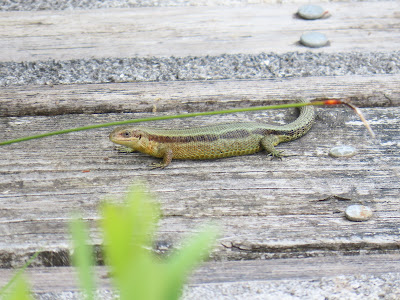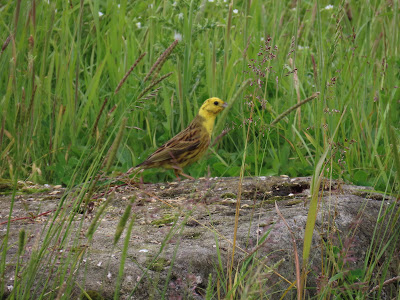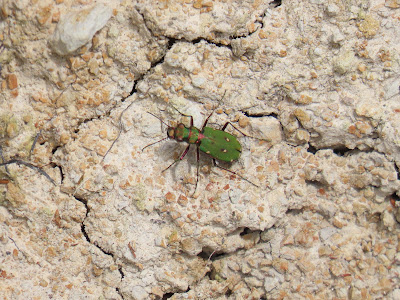It has taken me a while to write this but this is the first instalment of a series on Yorkshire bogs, which we are visiting to recce for an upcoming Bog Bush-cricket acoustic survey. Fen Bog and Tranmire Bog are small sites near each other, so we decided to start with them. Fen Bog is a Special Area of Conservation (SAC) and YWT nature reserve on Newtondale, a glacial valley where the Yorkshire Moors Railway runs from Pickering to Whitby. We walk along the wet footpath on the east of the valley, recording the diverse flora of the site, mostly species new to me, typical of wet heath, bog and mire habitats, and we keep our eyes open for bush-cricket nymphs. Siskins and Lesser Redpolls fly over calling and sing from the birches. We see no Bog Bush-crickets on site, despite the habitat looking spot on for them. We'll see what the acoustic survey reveals.
Latticed Heath moth.
Small Heath.
There are 18 m of peat stored under the wet valley bottom, still growing thanks to sphagnum moss.
Sphagnum inundatum, well saturated, one of the several species in the bog. Sphagnum mosses grow when wet, absorbing and fixing carbon dioxide from the air into their tissues. Due to the acidic conditions in the bog, dead tissues under the growing mosses don't decompose, rather accumulate, compact and eventually becomes peat stored under the bog. Maintaining bogs and mires wet, removing any artificial drainage and stopping peat extractions is crucial for the recovery of active bogs and for reducing atmospheric CO2.
Common Spotted Orchid.
Common Lousewort.
Bog Pondweed.
On the wetter flushes by the path, the reddish rosettes of Round-leaved Sundew.
There are large areas of Bog Myrtle on the valley bottom.
A Large Red Damselfly near the beck.
Lesser Redpoll singing.
Yellowhammer at the car park.
After lunch at a very well located bench overlooking the valley, and having seen the steam train across Fen Bog, it is time for the second site of the day, Tranmire Bog, a small bog right next to the Wheeldale Roman road as it crosses Wheeldale beck. To drive there we have to take a long detour via Goathlandbut as a bonus, we find a Grouse pair and a chick just by the side of the road. I take some photos from the car, these are a lifer for me!
Male Red Grouse.
Tranmire Bog is known for its dragonflies, with Golden-ringed Dragonfly in Rutmoor Bec, and Keeled Skimmer, Black Darter and Common Hawker present. It is located within the North Yorks Moor National Park. A Bog Bush-cricket record of an adult female in 2017 prompted us to visit this site, my first visit.
A General view of Tranmire Bog area.
Rutmoor Beck.
The small but stunning Tranmire bog, the bog covered on Bog Bean, with a drift of Cotton grass in the distance.
Green Tiger Beetle.
Bean Bog.
Adder shed skin. We find several pieces of skin across the side of the bog.
Sphagnum moss.
More informationYWT site for Fen Bog.
Special Area of Conservation designation. JNCC site.
Yorkshire Dragonfly Group Tranmire bog site.
















































